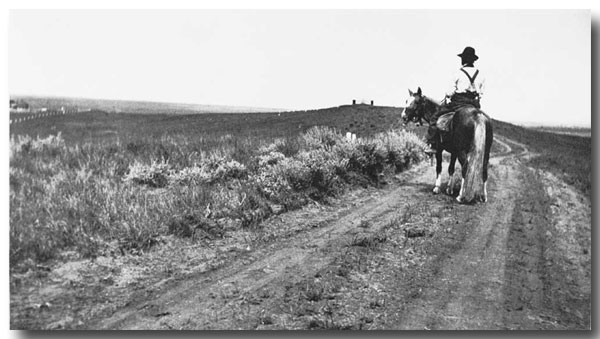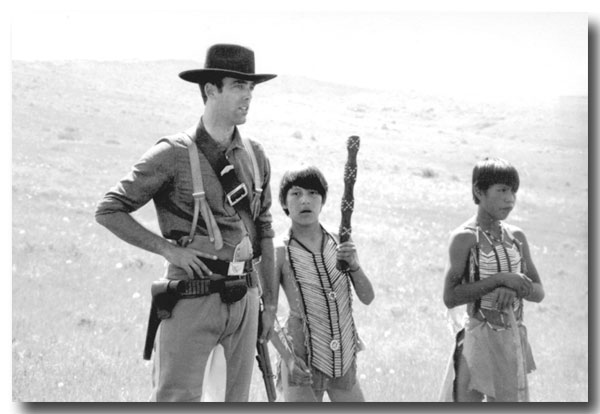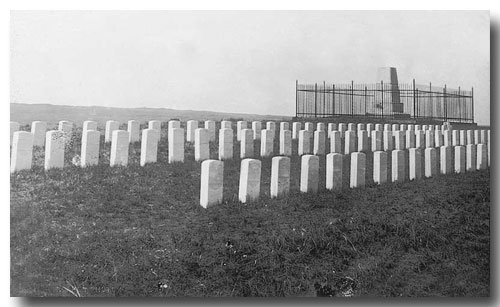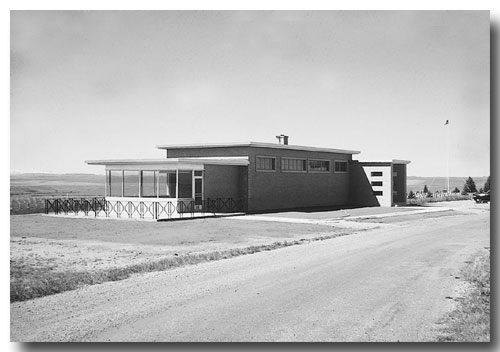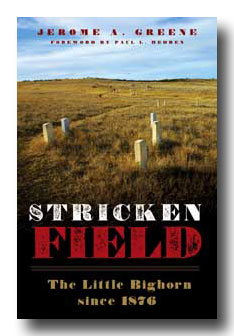| Friends Of The Little Bighorn Battlefield |
The Next Generation In The Study Of Custer's Last Stand |
Stricken Field: LBH Since 1876 |
| • The Battle • Archeology • Memorials • Little Bighorn Store • News • Book Reviews |
Stricken Field: The Little Bighorn Since 1876By Jerome GreeneBook Review by Bob Reece, February 2008All excerpts and photos from Stricken Field, copyright by Jerome Greene and University of Oklahoma Press.
I think the government can do no less than to give these remains
decent burial, by putting them in coffins, and remove them to some suitable
place….It is hard for me to understand how the remains of the officers could be
in condition for removal….while those of privates and non-commissioned officers
had become food for wolves….I want to secure the body of my son. The pain and suffering from Mr. Staples's words leap out at you and hit you directly in the face. His son was Corporal Samuel F. Staples who died with Company I along battle ridge. These words from a father who lost his son at the Battle of the Little Bighorn would have a direct effect on the establishment of the Custer Battlefield as a national cemetery. One man can make a difference.
Looking south to north along the rutted dirt road on Battle Ridge
The story of Staples's father is just one of many new finds discussed in
Jerome Greene’s Stricken Field: The Little Bighorn Since 1876 (Stricken
Field). The
history of Custer Battlefield can be more fascinating than the battle
itself: These are just some of the questions answered in Stricken Field. Every student fascinated with this place must understand its past to better understand it today, and to help protect it forever. Jerome Greene masters all of this in his magnum opus.
A young Jerome Greene, historical aide at Little Bighorn
Stricken Field evolved from Mr. Greene’s official 2005 report to the NPS at the request of former Superintendent Neil Mangum, current Superintendent Darrell Cook, and Chief Historian John Doerner. For more background on this please read our interview with Mr. Greene. A study such as this was desperately needed. The only other history was written by past Chief Historian Don Rickey, Jr., but it covered only the first 80 years. It was time to make it current. Mr. Greene opens with an overview of the Custer Battle. The purpose of this book is not to rehash the battle in detail and Greene sticks to that purpose; his narrative on what happened to Custer and the 7th Cavalry is short and to the point. There is too much ground to cover after June 25-26, 1876, and Mr. Greene accomplishes that with depth and clarity. Mr. Greene takes a complex subject (just keeping track of all the name changes at Custer Battlefield is difficult enough in itself) and helps us to more easily understand those complexities. Here you will discover the different government agencies that were responsible for the battlefield, how they saw their role in managing the place, the actions they implemented to accomplish their mission, and the people involved. The different monuments and burials are covered: what happened to the Custer dead and the difficulties that followed in administering the national cemetery; how and why the remains from Fort Phil Kearny were reinterred on Last Stand Hill and what happened to them afterwards; the placement of the 7th Cavalry Monument; the repositioning of the Fort C. F. Smith monument and the Reno Monument; and the soldier and warrior markers. What about the visitor center and the Stone House as well as the other structures on the battlefield? The answers are shared in vast detail by Mr. Greene.
Remains from Ft. Phil Kearny on Last Stand Hill Learn more about this photo here and here
For me, one of the most fascinating segments of Stricken Field is the chapter regarding interpretation. All of us who are lucky to visit the battlefield on a regular basis are very aware of the interpretation that takes place there. It was not always so. During the War Department’s administration, its primary focus was the many reinterments from the various western forts and maintaining the national cemetery. Interpretation was not their mission. That was furnished by Crow tribal members who accompanied visitors. Interpretation did not really begin until management of the battlefield was transferred from the War Department to the Department of Interior and the NPS in 1940 (It is even more fascinating to learn why the transfer did not occur sooner.) Reading how research and interpretation flourished at the battlefield is inspiring. All of us can be thankful for the vision that the first NPS superintendent Edward Luce and second NPS park historian Don Rickey, Jr. dreamed up in this endeavor. Their work still has an impact on the battlefield with the placement of red granite markers for fallen warriors.
Visitor Center as it first appeared in 1952
Mr. Greene does not shy away from the many contentious battles waged against the NPS by the Custer Battlefield Historical and Museum Association (CBHMA), and Little Big Horn Associates (LBHA) respectively. Few battles benefited the battlefield as in the case against the partnership between NPS and North Shield Ventures; however, once we see all these clashes laid out before us, we realize how most of them were fought more for personal wants of the CBHMA or LBHA rather than enhancement of the battlefield. Many of the younger generation interested in this battle are not even aware that the CBHMA was once a cooperating association with the NPS and managed the visitor center bookstore. Mr. Greene clearly covers the many successes the CBHMA achieved when cooperating with the NPS, as well as its tragic downfall from it becoming extremely adversarial. What is completely absorbing is another discovery by Mr. Greene in a letter written by Walter Camp to General Godfrey on November 6, 1920. In this very lengthy, never-before-published letter, Camp offers in-depth complaints about incorrect placement of soldier markers and the reinterment of the Fort Phil Kearny dead on Last Stand Hill. These very same arguments can be heard at the battlefield or made against the NPS today.
Two aerial views above taken in the 1930s. Seen are the Stone House, cemetery rostrum, fenced monument, and Last Stand Hill
August 10, 1983 -- "The grass fire that swept through the Custer Battlefield area of the park." Learn more about the 1983 fire
Mr. Greene concludes Stricken Field with a chapter about the Indian Memorial and the battles fought by American Indian groups and individuals to honor their fallen warriors. Because of Mr. Greene’s extensive research, we wholly comprehend the failures of the War Department and NPS in not listening to the needs of these Americans. But we also appreciate the achievements of the Indian Memorial and warrior markers that eventually took place because the NPS finally listened. Those successes began from bold initiatives set by the first American Indian superintendents, Barbara Booher and Gerard Baker. Their efforts began the building blocks of trust between the NPS and the Indian community. Immediately afterwards and during Superintendent Neil Mangum’s administration, he harbored that trust and did not take it lightly; the consequence was dramatic change to the face of the battlefield for the better and forever. Mr. Greene documents Mr. Mangum’s fight to finally have the Indian Memorial constructed. It is during the Indian Memorial dedication at the battlefield on June 25, 2003 that Mr. Greene ends this story. Stricken Field leaves one breathless for its complete annals of the Little Bighorn Battlefield National Monument and its transformation from a small national cemetery without an official name to a magnificent Monument where all Americans now feel welcomed. What changes will we witness at Little Bighorn over the next 50 years? Who can say, but I envy the next generation that will experience that change.
Stricken Field includes nearly 100 photographs, many never-before-published. A complete listing of all the War Department and NPS
superintendents (some photos as well) are included. Three appendices
include the general orders establishing the Custer Battlefield as a
national cemetery, as well as other legislation involving the name change
and the Indian Memorial. Six maps are included. Webmaster’s Note: What's next for Mr. Greene? Still years away from publication, he is beginning research to tell the first complete story of Wounded Knee replete with Indian accounts. Referenced In Stricken FieldNeil Mangum's "Confession of a Park Ranger" Megan Reece's history of the Indian Memorial Further Reading Covered In Stricken FieldLearn more about the burials and reburials of the Custer dead History of the warrior markers Books On The Horizon Home |
|
||
|
Copyright 1999-2016 Bob Reece Friends Little Bighorn Battlefield, P.O. Box 636, Crow Agency, MT 59022 | Home |
Board of Directors |
Guest Book | Contact | Site Map
| |
|||
